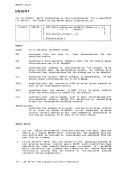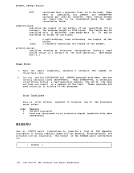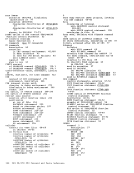DLBL
TheOLBL command does not check the extents to see whether they are
on cylinder boundaries or whether they are entered in the proper
sequence. Ifyou do not enter them correctly, the access method services
DEFINE function will terminate with an error.eMS assigns sequence numbers to the extents according to the order in
which they were entered. These sequence numbers are listed when you use
theLISTDS command with the EXTENT option.
In order to display the actual extents that were entered for aVSAM data set at DLBL definition time, the following commands may be entered:
DLBL(EXTENT) or QUERY DLBL EXTENT Either of these commands will provide the following information to
the user:
DDNAME TheDOS filename or OS ddname. MODE The CMS disk mode identifying the disk on which the extent
resides.LOGUNIT The DOS logical unit specification (SYSxxx). This operand
will be blank for a data set defined while inCMS/OS environment; that is, the SET DOS ON command had not been
issued at DLBL definition time.EXTENT Specifies the relative starting track number and number of
tracks for each extent entered for the given dataset ddname.
If no DLBL definitions with extent information are active, the
following message is issued:DMSDLB324I NO USER DEFINED EXTENTS IN EFFECT EXTENTS: When you want to execute a program or use access method services to reference an existing multivolume VSAM data set, you must use the MULT option on the DLBL command that
identifies the file.When you use the MULT option, you are prompted to enter additional
disk mode letters, as follows:
assgnsys001 c
assgnsys002 d
assgnsys003 e
assgnsys004 f
assgnsys005 9 dlbl infile c {mult sys001 DMSDLB330R ENTER VOLUME SPECIFICATIONS: d sys002, e sys003 , f sys004 g sys005 (null line)
Theabove identifies a file that has extents on disks accessed at mo es
C, D, E,P, and G. These disks have been assigned to the logical un ts SYS001, SYS002, SYS003, SYS004, and SYS005. The rules for enter ng
multiple extents are:• All disks must be mounted, accessed, and assigned when you issue the
DLBL command.• You must not repeat the mode letter and logical unit of the disk that
js entered on the DLBL command line (C in the above example) .Section 2. eMS Commands 65
The
on cylinder boundaries or whether they are entered in the proper
sequence. If
DEFINE function will terminate with an error.
which they were entered. These sequence numbers are listed when you use
the
In order to display the actual extents that were entered for a
DLBL
the user:
DDNAME The
resides.
will be blank for a data set defined while in
issued at DLBL definition time.
tracks for each extent entered for the given dataset ddname.
If no DLBL definitions with extent information are active, the
following message is issued:
identifies the file.
disk mode letters, as follows:
assgn
assgn
assgn
assgn
assgn
The
C, D, E,
multiple extents are:
DLBL command.
js entered on the DLBL command line (C in the above example) .






















































































































































































































































































































































































































